
How to create a welcome email series for new contacts
When done right, welcome email series can bring impressive results. This article explains why you should create one for your business and shows a few tips and examples on how to do it right.
Why do you need a welcome email series?
Welcome emails are perhaps the most important email marketing messages in your email program. Why? Because your contacts tend to be most engaged right after they register. Our latest data shows that the average open rate of a welcome email is over 82% and the average click-through rate is around 27%.
That means more than eight out of 10 people will open your welcome email. And more than one in four will click through to your site.
Here are my top 3 reasons why you should create a welcome email series:
- It makes new contacts feel welcome.
- It shows new contact that your email program is working.
- It provides people with the information they need to make an informed decision about the purchase.
As you can see, you could meet all the criteria above with just one welcome email. But planning a welcome email series allows you to present more information in easy to digest portions. It also provides more touchpoints to interact with your audience so that you can learn more about their needs and preferences.
What makes a great welcome email series
The way you communicate with your target audience is unique, and so is your email marketing. Each welcome email series is different. However, there are a few factors that make welcome series great.
It introduces your brand to the world
Welcome emails are a great way quickly show what your brand is all about. Combine great design with powerful copy in order to reveal your brand identity.

A welcome email from The School of Life. One message conveys the purpose of the business, offers incentive to make a purchase, and promotes all assets.

A welcome email from Fellow – simple yet informative.
Provides contacts with valuable information
You can use welcome email series to onboard new contacts - send them key information that will help them make an informed purchase decision or help them make the most of your product or service.
Take a look at this welcome email series form one of our customers - LandCafe.pl. They found out that only the people who know the difference between the coffee widely available in shops and artisanal beans roasted in small batches become their customers.
This is why they decided to create a series of 6 emails in order to educate their contacts. Each email provides valuable information, e.g.
- Where does LandCafe.pl coffee come from?
- Why you should choose coffee from a roastery?
- What are the main characteristics of coffee from different continents?
- What’s the difference between single and blend?
- How to read the labels?

A 6 email welcome series from LandCafe.pl
Are you interested if the business results? We’ve collected the data, and they are truly awesome:
- 41.33% of contacts made a purchase during the welcome series
- 13.3% of contacts were triggered to buy with a discount coupon right after the welcome series
That’s a solid business case for a welcome email series in ecommerce.
Allows you to get to know your audience
A well-planned welcome email sequence allows you to learn more about you contacts and personalize further communication.
There are a few ways in which you can collect valuable information:
- design email segments with multiple CTAs. You can figure out contact preferences based on the ones they click.

A fragment of an email from Movement with two CTAs directing to different product categories
- run surveys and quizzes in order to quickly collect more meaningful data.

An email form care/of inviting to take the powders quiz.
- track website activity and see what products and content your contacts visit the most.
Make the effort to find out more about your audience. It is mutually beneficial. With the right data, you can focus on what is important and send less emails and your audience will receive only relevant emails.
How to automate the process:
If you use PrestaShop, you can integrate your store with GetResponse – all-in-one marketing software perfectly suited for your business marketing needs. This free integration allows you to add PrestaShop newsletter subscribers to the welcome cycle automatically.
Building your first welcome email series is easy with the available marketing automation templates.
The following one allows you to send one email right after signing up for the newsletter and the second one 2 days later.
You can also develop a tagging plan and segment your contact list.

A marketing automation template to welcome new contacts
Here’s what you’ll need to configure the elements and publish the template as a workflow:
- 2 emails that can be used as automation messages,
- Tags (optional). They will help you identify your customers if you want to target them specifically or add them to another workflow. You can create tags as you’re building the workflow, but its best to have a basic tagging plan set.
Now it’s your turn
Now you know why welcome emails are great both for new contacts and your business. I hope that you’ll find the tips and examples in this article useful for building your welcome email series.
Check out the GetResponse Module for PrestaShop and create a welcome series your contacts will love!





